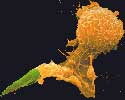Parasites In Humans
Find The Nastiest Parasites In Humans
LeishmaniaLeishmania is a microscopic protozoon and is responsible for a disease called leishmaniasis. Leishmaniasis is spread by sandflies and about 12 million people are infected worldwide. It causes the most parasitic deaths after malaria. The two most common forms are visceral and cutaneous leishmaniasis. There are about 500 000 new visceral leishmaniasis cases each year. More than 90 % of the visceral leishmaniasis infections take place in Bangladesh, Brazil, India, Nepal and Sudan. The disease develops a few months after the sandfly bite and causes:
There are about 1.5 million new cutaneous leishmaniasis cases each year. The disease causes skin sores a few weeks after the bite. The sores vary in appearance and might or might not be painful. A fully developed sore usually has a raised edge and a central crater. Some sores are covered by crust tissue. Nearby lymph glands might swell up, if the sore is located further from the heart than the glands. Over 90 % of the cutaneous leishmaniasis infections occur in Afganistan, Algeria, Brazil, Iran, Iraq, Peru, Saudi Arabia and Syria. Leishmania parasite has two separate life forms. In humans it mainly lives as amastigote which does not have flagella to move around with. Inside insects Leishmania appears as promastigote which has a flagellum and is able to move. When a sandfly infected with Leishmania feeds, the parasites are transmitted to the biting area. Sandflies are smaller than regular mosquitoes and fly very quietly. Their bite might be painless and might go unnoticed. Leishmania uses your white cells as a hiding place so it lets a phagocyte eat itself. Neutrophil granulocytes are the first phagocytes that arrive to the infected area. They immediately start consuming the Leishmania. To prevent granulocytes from killing it, Leishmania releases special chemicals. These chemicals make the granulocytes harmless and signal other immune defense cells that everything is under control. The chemicals also prolong the life span of the neutrophil granulocyte from 6–10 hours to 2–3 days. Leishmania does this to get inside macrophages. This would not be possible without the delay because it takes about 2 days for macrophages to arrive to the infected area. When the macrophages finally arrive they do not see any parasites. They only find old neutrophil granulocytes which are signaling the macrophages to go ahead and eat them. Since the parasites are inside the granulocytes the macrophages cannot see them and will not bother using any killer enzymes for the ingested granulocytes. This is because the granulocyte is signalling the macrophage that "I'm too old to live so I'll release my own decomposing enzymes. You, my dear macrophage, you just go ahead and eat me and I'll destroy myself once I get inside you." This is how the parasite gets inside a macrophage which have much longer life expectancy (up to many months). So Leishmania has enough time to reproduce inside the host cell. As soon as the macrophage is filled with Leishmania, it bursts and the parasites start looking for new hosts. Diagnosis is done by doing lab tests. Depending on the particular Leishmania species and the location of the infection, different treatment is used. There is a new drug sodium stibogluconate, which might become the preferred medicine in the future. Currently it is not available in every country.
Also check out the videos.
|
Parasites In Humans Pictures And Videos Contact Info Privacy Policy Sitemap
© 2010–2015 parasitesinhumans.org



